Kid-friendly Boardgame Round-up
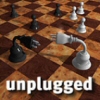 Gaming isn’t always about serious strategy, staring at a board until your opponent makes their next thoughtful move. There are many games on the market perfect for players looking to add a bit of dexterity and/or silliness to their next game. This can be great for younger gamers who might otherwise have a hard time sitting still. Here are a few games I’ve played over the past few months that seem to fit the bill.
Gaming isn’t always about serious strategy, staring at a board until your opponent makes their next thoughtful move. There are many games on the market perfect for players looking to add a bit of dexterity and/or silliness to their next game. This can be great for younger gamers who might otherwise have a hard time sitting still. Here are a few games I’ve played over the past few months that seem to fit the bill.
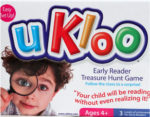 Ukloo (Riddle Edition / Early Reader) by Ukloo Kids Inc.
Ukloo (Riddle Edition / Early Reader) by Ukloo Kids Inc.
Less of a boardgame and more of an activity, Ukloo provides a deck of cards containing clues to items commonly found around the house. The cards come in three levels, roughly corresponding to the difficulty of the clue (both in vocabulary and critical thinking.) One person (a parent or other player) hides several cards around the house in a “chain” – where one card is placed at the location of the answer to the previous clue. The players then race through the house (either cooperatively or separately) to chase down the clues to find the final one. The finders can then score points or win some other reward.
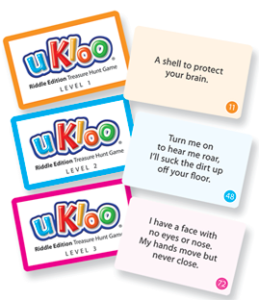
In practice, I typically just use the cards for a fun scavenger hunt around the house – with no real goal other than finishing off the clue chain. Once one chain is finished, another player gets a chance to set up the next round of clues.
The game actually comes in two versions. The standard (Riddle edition) has challenges and appropriate vocabulary for kids around 5 or 6. The Early Reader edition has simpler clues and very beginner vocabulary, making it possible for kids around 4 or 5 to play. As it is part of a game, the reader edition can be a great way to spur younger kids on in their reading abilities.
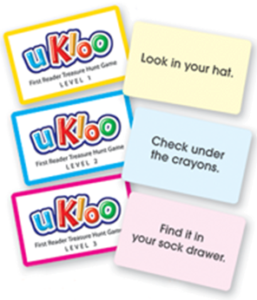
Verdict: One could simply recreate the same idea around the house by making one’s own clues, having a premade set is great for setting up a quick game. While the limited number of included clues will eventually run out, some can be reused several times as they may refer to several possible places in the house. When things become too tame, the included clues also serve as examples to emulate when creating one’s own. The early reader edition.
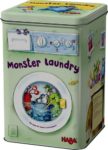 Monster Laundry by HABA
Monster Laundry by HABA
The first step in Monster Laundry is to take the stretchy laundry line (an actual stretchy rope) and place it around the players. (The rules suggest beneath their shoulders, while I prefer around each player’s neck.) A pile of clothespins and paper monster are placed in the center of the players. The game is then played in alternating phases. On odd rounds, players race to collect all of the monsters of their color and then hang them on the clothesline. However, the monsters are wearing either stars or spots. Star monsters must be clipped to one’s left and circles to one’s right. The first player to finish is awarded a golden clothespin.
On even rounds, players attempt to clip up one monster of each color, and the fastest is again given a golden clothespin. Players alternate rounds until someone earns three golden clothespins and is declared the winner.
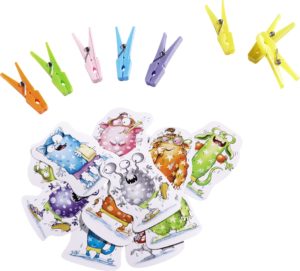
Verdict: A fun little game that should appeal to younger (5-10) gamers. Adults may enjoy a game or two for the novelty, but there isn’t any deeper strategy or ongoing humor to support further play. As is common with dexterity games like this, when one player is slightly better than the others, that player will end up winning nearly every round and the game will end with a runaway victory. The game does have some suggestions for handicapping players (primarily delaying one’s start) but these are only marginally effective if playing with multiple children (who often resent artificial handicaps.) It is basically fun, but after a couple plays, my children and I are looking for something else.
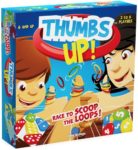 Thumbs Up! by Blue Orange Games
Thumbs Up! by Blue Orange Games
In Thumbs Up!, players race to place colored rings onto their thumb in a specified order. One player flips up a card from the central deck. Players then race to place the appropriate rings onto their thumb in the correct order. The first player to complete the challenge and yells “thumbs up” gets to keep the challenge card. Collect five challenge cards to win the game.
A simple little speed dexterity game, accessible to nearly all ages. Reading is not required but kids need to be able to quickly sort numbers 1 to 5 in correct order. The cards are the best part of the game. They are not simply a listing of rings and colors, but are numbers displayed in creative ways. They may be laid out in overlapping balloons, a set of gears, sport jerseys and balls, etc… The variety of images prevents a fairly simple game from becoming too stale by changing the cards just enough to require some concentration to the order in addition to the skill needed to correctly stack up the rings.
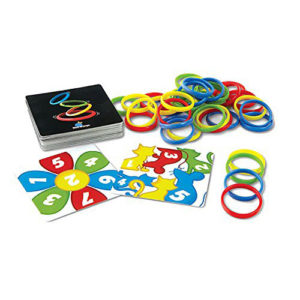
Verdict: A nice, inexpensive game that is easily grasped and quickly played. There is no strategic depth here, but it isn’t needed. Its simplicity allows for younger players, but fast evaluation of the order of rings on the card is still needed. The main downside is the same for many of these types of dexterity/reaction games, the player who is just slightly better will win almost every card. The game is best when players have nearly the same level of ability. One option when playing with children, is to require them to only stack a subset of the listed rings.
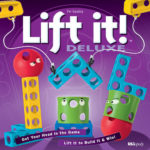 Lift It! Deluxe by USAopoly
Lift It! Deluxe by USAopoly
In Lift It!, players attempt to build a stack of objects displayed on a card. The challenge lies in using the provided plastic crane to hook each object (which are full of holes) and lift it into its correct place. As with other games of this type, players score points to advance around a board to be the first to collect enough points. Sometimes players race against time and other times they race each other. I tend to ignore the boardgame aspect completely, and treat it as a series of one on one (or 1 on 1 on 1) races to complete any given card. The game scales with ability, as the cards come in multiple difficulty levels. Thus it could theoretically be a race between younger and older gamers by providing the younger (or at least less able) gamers with easier things to build.
My favorite way to play is by attaching the cranes to players’ heads. There is a handy elastic strap that lets players attach the crane to their forehead. They must then use their head (and crane) in order to lift and place the objects to match the card. The game isn’t all that deep or long, but played in “forehead” mode, it is entertaining for everyone (player and watchers) involved.
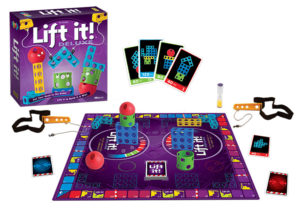
Verdict: A highly entertaining game that creates fun by making players act in unconventional ways. Since some challenges are simply a race against time (and not head to head) the game doesn’t suffer as much from slight differences in player ability. This is the sort of game you can break out at a party or gathering and it will entertain both players and watchers.
Kid Factor:
All four games are great games for kids, while all but Ukloo can entertain adults in the right setting. Due to the speed factor, the dexterity games can strongly favor slight differences in ability – although Lift It! mitigates this somewhat by offering solo timed challenges. Thankfully, it is not hard to create some handicaps when playing with younger players. All four games target younger players, but I find Lift It! as the best game of the bunch if playing in a “grown-up” crowd. This is partly due to the challenge, but also due to the funny situations it can evoke.





Discussion Area - Leave a Comment